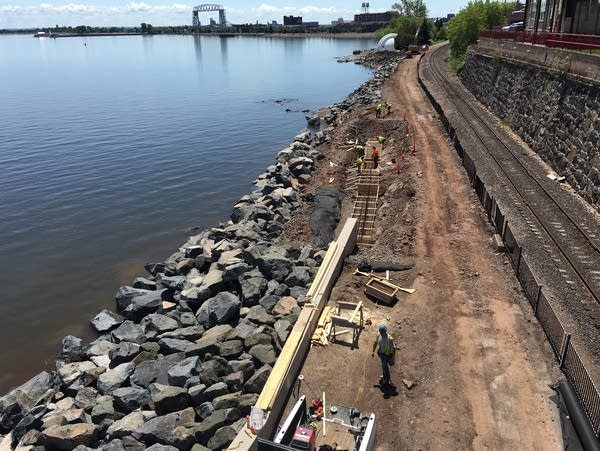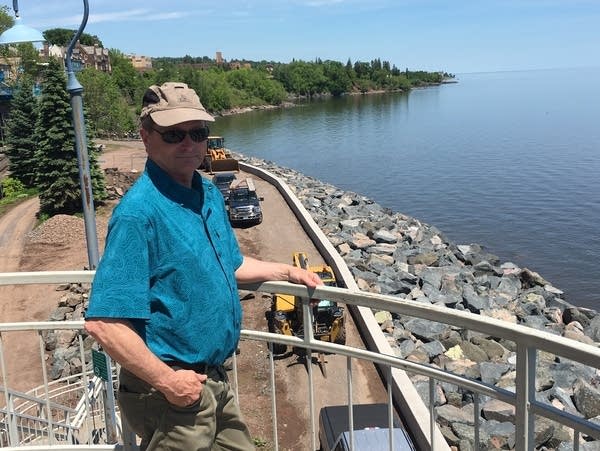In Great Lakes, high waters cause headaches, uncertainty

Go Deeper.
Create an account or log in to save stories.
Like this?
Thanks for liking this story! We have added it to a list of your favorite stories.
The city of Duluth has learned the hard way these past few years just how powerful Lake Superior can be.
In October 2017, 60 mph winds sent huge waves crashing into shore, shredding sea walls, destroying roads and eroding the lakeshore.
Six months later, another big storm caused yet more damage.
And then last October, a third storm hit — the biggest one yet.
Turn Up Your Support
MPR News helps you turn down the noise and build shared understanding. Turn up your support for this public resource and keep trusted journalism accessible to all.
"It’s been hard for the city to catch its breath, frankly,” said Mike LeBeau, Duluth's construction project supervisor.
The city’s popular Lakewalk pedestrian and biking path, just blocks from the heart of downtown, was especially hard-hit after being hammered repeatedly by the storms.

The boardwalk itself withstood some structural damage, but it didn’t stop there. LeBeau ticked through the weather’s impacts: “It undermined the buried electrical wiring for the lights, tipped over some lights, flipped the boardwalk sections up near the hotels, even."
And it eroded away acres of land, upending large boulders that had been put in place to protect the Lakewalk and tossing them easily out into the water.
Lake Superior's gales are legendary. But the high water levels, LeBeau said, have made these recent storms even more destructive. The city has estimated damage from the three storms, in less than two years’ time, at nearly $30 million.
It's a similar story elsewhere around the Great Lakes, where beaches have disappeared, docks are submerged, and lakeshore is eroding.
But the higher water levels have been a boon for the shipping industry. That's because deeper water allows ships to carry more cargo.
"A great example of this is a vessel like the Edwin H. Gott, which can carry an additional 267 tons of iron ore per extra inch of draft,” said Jayson Hron, spokesperson for the Duluth Seaway Port Authority.
"That’s something like $26,000 worth of extra ore per inch, so if you multiply that by 2 or 3 inches of water level, and then multiply it by more than 30 trips over the course of a shipping season, it adds up to some significant benefits,” he said.
Only six years ago, the shipping industry was complaining about record low water levels.
In the late 1990s, Great Lakes water levels began dropping — quickly.
The decreased levels happened because warm lake temperatures led to high evaporation rates, said Drew Gronewold, a University of Michigan environmental science professor and former hydrologist at National Oceanic and Atmospheric Administration’s Great Lakes Environmental Research Laboratory.
That downward turn lasted 15 years.
"There really isn't a period of below-average water levels in the record for quite that long a time period,” Gronewold said. Great Lakes water data goes back a century.
But in 2014, lake levels started to rise — fast.
"It was a very rapid transition,” Gronewold said, “one of the most rapid water level increases in history."

That rise has continued into this summer: Lakes Erie and Ontario have reached their highest levels ever recorded, and Lake Superior has set new monthly records.
This time, the spike in water levels was driven largely by an increase in rain and snowfall — over the Great Lakes themselves, and on the surrounding land that runs off into them — said Lauren Fry, a hydrologist with the U.S. Army Corps of Engineers’ Detroit district.
“Over the past six years, we’ve had above-average water supply more often than not,” she said, “so, it’s been an ongoing building of high water levels, culminating this season.”
Increased precipitation, including more extreme rainstorms, is one of the chief signs of climate change in the Upper Midwest, Gronewold said, since the warmer atmosphere holds more moisture.
But the water level rise also coincided with some extremely cold winters, including the cold snap in 2014 caused by the “polar vortex,” which produced record-breaking ice cover on the Great Lakes. And that, in turn, slowed down evaporation rates. Because the ice was so thick and so comprehensive, it took much longer to melt than usual.
On the one hand, said Gronewold, “precipitation is going up, with more severe events.” But on the other hand, evaporation is also likely to increase again at some point.
He calls it a tug of war — with both sides pulling more strongly.
“The oscillation between those two extremes is what could be leading to more future rapid oscillations between extreme water levels, as well," Gronewold said.
In other words, these rapid transitions between high and low water levels may be the new normal for the Great Lakes.
That puts people who live and work along the lakes in a tough spot, Gronewold said, when compared to their counterparts in cities on the ocean coasts, who only have to prepare for sea levels going in one direction: up.

Mike LeBeau, who oversees construction projects for the city of Duluth, says the city doesn’t have many options for moving the Lakewalk, especially the section beneath the Fitger’s Inn and market house. With a big retaining wall behind it, there’s no place to move.
"There are places where the solution is retreat,” LeBeau said. “And there was nowhere to retreat here. So, we have to do the best that we can come up with and afford and hope that it lasts a long, long time.”
That meant designing a more climate-resilient Lakewalk. Crews hauled in giant boulders, weighing 3 to 4 tons apiece, for the foundation. They sunk an 18-inch concrete wall 12 feet deep in places, and built a thicker paved trail. The first two phases have cost $3 million.
But even with those precautions, LeBeau concedes it may not be enough to withstand the full extent of Lake Superior’s power.
“You know,” he said, “we may not have seen what the storm can totally do yet."


